Middle School Girls Learn About Materials While Doing Cool Hands-On Activities to “Make Stuff Better”
“I do this, and I will always do this because I think that this is a very crucial age group.” Cecelia Leal on why she does the Mid-GLAM camp.
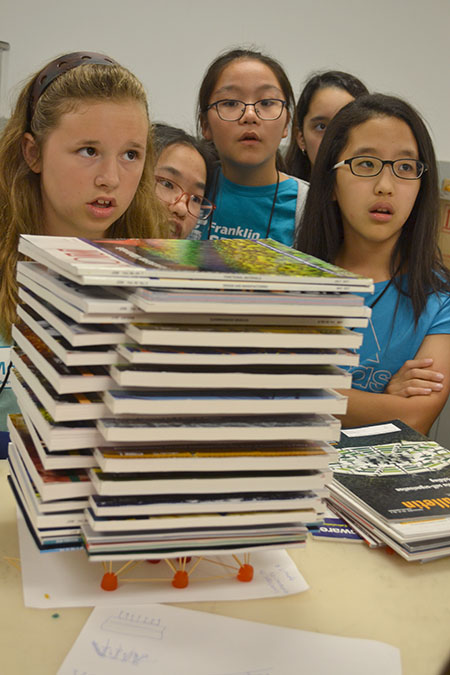
A team of Mid-GLAM campers test the toothpick/gumdrop structure they built by stacking academic journals onto it.
August 5, 2019
Twenty-two middle schoolers showed up on campus from July 15–19 for Mid-GLAM, a summer day camp designed to pique middle school girls’ interest in materials engineering. In its third year, the camp, led by Materials Science and Engineering (MatSE) Assistant Professors Cecelia Leal and Robert Maass, introduced girls to materials via fun, hands-on activities.
According to Leal, Mid-GLAM, which gets the acronym part of its name from the long-standing materials science camp for high school girls—GLAM (Girls Learn About Materials)—was even more diverse this year than in the previous two years. One reason is they reached out to schools outside the Champaign-Urbana area. For instance, they had a participant from Bloomington, Illinois; one from out of state (Indiana); they even had a camper from Europe. While this is a day camp, it works out for these out-of-towners because some of them have family nearby. “A very diverse and fun group,” Leal reports.
Camp activities encouraged the girls to consider how to “make stuff better.” So the various hands-on activities were related to: “Making Stuff Colorful,” “Making Stuff Change Color;” “Making Stuff Prettier;” also, making stuff smarter…safer…stronger…cleaner/ recyclable...and faster! For example, during one activity, campers made some quite pretty ooey, gooey, oobleck and slime that contained glitter and changed color based on temperature.
In another activity about making stuff stronger, girls used toothpicks and gumdrops to make structures, which they then tested by piling on academic journals (in some cases, a great number of them!). In another activity, groups of girls predicted then tested the strength of various materials (newspaper, plastic wrap, aluminum foil, copier paper, wax paper, and freezer paper) by dropping a spoon from increasingly greater heights. Participants also made batteries and tested their effectiveness.
Leal shares why she finds time for the camp in her busy schedule: when she was young she participated in similar activities that she believes impacted her career choices: “I do this, and I will always do this because I think that this is a very crucial age group. There's so many outreach events for high schoolers, but for the middle school age group…nothing like this.” She shares that she, personally, benefitted from STEM activities in her own school. “But any activity that was offered, I would jump on it,” she recalls. “And I think this age group is really where you can make an impact.”
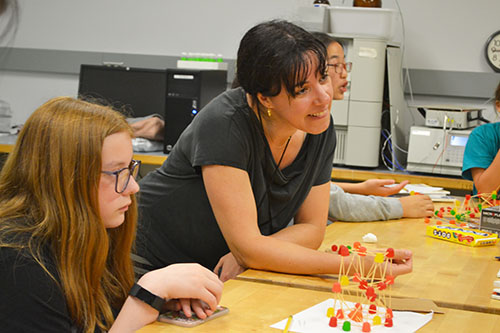
Ceclia Leal (center) enjoys watching a team's toothpick/gumdrop structure being tested.
In fact, she is committed to the camp long-term and would love to see additional camps for this age group in other engineering disciplines: “So I will always do this. If I’m not here physically, I will delegate. I want to make sure that this camp continues, and hopefully more with other themes, right? This is a materials theme, but I would like to see it expand to other fields of engineering. And so I want to be able to sustain this. It's important.”
Her fellow Mid-GLAM co-coordinator Robert Maass indicates that he’s involved with the camp for a number of reasons.
“So it's fun,” he explains. “It's a good distraction from the research and teaching activities we do during the regular semester times,” he adds.
He also sees it as a way to get more girls into engineering.
“There's a hope that some of these campers or girls actually come back and find the engineering interesting.” In fact, as long as they end up in engineering, he’d even be happy if they ended up going someplace other than Illinois. “ So if every year there's one or so that, because of an experience like this, decides to go for an engineering education, that would be great,” he adds.
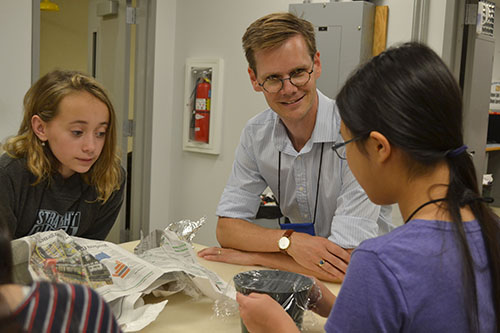
Robert Maass (center) interacts with a team of campers testing various materials during the spoon drop activity.
And of course, he just enjoys teaching the youngsters. “It's a fun thing to do,” he adds. He does admit that one of the challenges regarding the camp is communicating his field in a way that middle school kids can understand. “It's difficult,” he admits, “because I can't use the words I would use normally. So that's a challenge.”
He says another challenge is keeping ahead of the kids, who appear to be much more knowledgeable than he was at their age. He relates a recent activity where they tested the strength of different materials. He thought he had come up with an exotic material for the test—Kevlar—but they knew all about it already. “For me, when I was a kid, Kevlar, I did not know about it. But now everybody knows about Kevlar.” So another challenge is coming up with something they’re not familiar with.
“But, it's a good challenge. I mean, every year, you get a new group of campers and you get to learn how the younger generation is keeping you young a little bit as well, which is nice.”
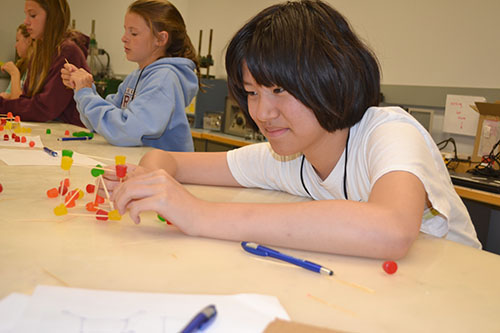
During the camp's making stuff stronger segment, a middle schooler works on her team's toothpick/gumdrop structure.
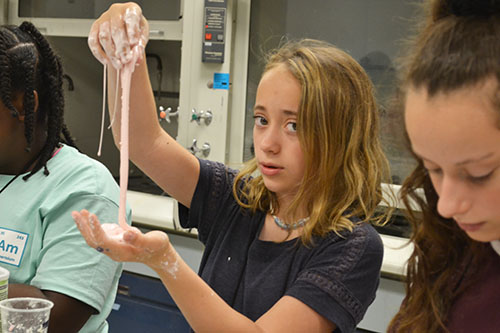
A camper plays with slime during one of the hands-on activities.
Regarding the camp’s overall impact, Maass reports, “I think it goes up and down, to be honest. Some of the activities may have been maybe a bit too academic or maybe there's too much of sort of the lecture style.” He adds that the activities with the biggest impact were the hands-on activities done in groups. He says Monday’s color-changing slime with glitter was a big hit.
“So that thing…so there's temperature involvement and change of colors. That's always very popular. It's very complex in terms of the science, but I think maybe the science part folds a little aside and it's more of a playpen than anything else.”
He shares another challenge they encountered when doing an activity involving telephones: “Truth is, you have to fight the distraction and fun factor they experienced from the phones. So that's something that's also a challenge. Well, it's hard to avoid at some point.”
Despite the challenges of working with a younger crowd, Maass admits: “So it's really fun. I really…I like the switch. It's a very good distraction from the other regular brand full of paper writing and things.”
Story and photographs by Elizabeth Innes, Communications Specialist, I-STEM Education Initiative.
More: 6-8 Outreach, GAMES, GLAM, MatSE, Summer Camp, Women in STEM, 2019
For additional I-STEM articles on Materials Science and Engineering camps and outreach activities, see:
- Mid-GLAM Camp Exposes Middle School Girls to Materials Science and Engineering
- Girls Learn About Materials Science at the 2016 GLAM G.A.M.E.S. Camp
- GLAM Seeks to Capture Girls' Imagination About Materials
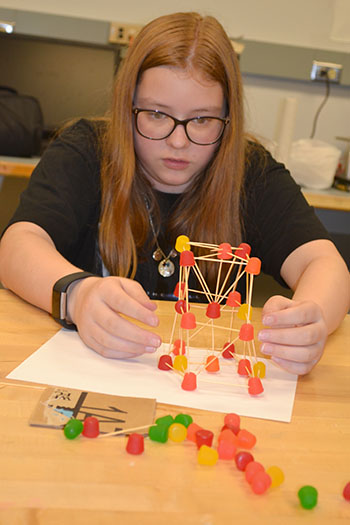
A Mid-GLAM camper works on her team's toothpick/gumdrop structure.
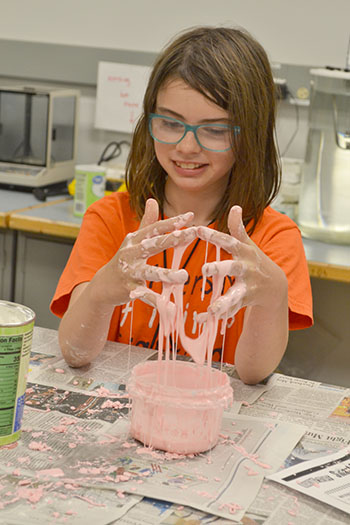
A Mid-GLAM camper plays with some Oobleck she made during one of the hands-on activities.
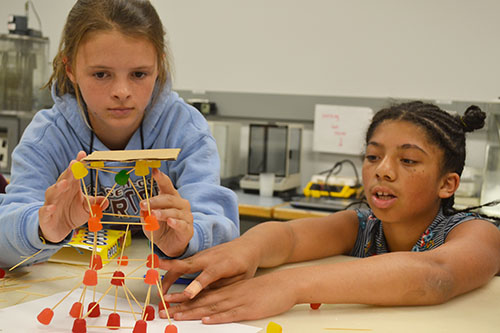
Two campers build a structure out of toothpicks and gum drops.
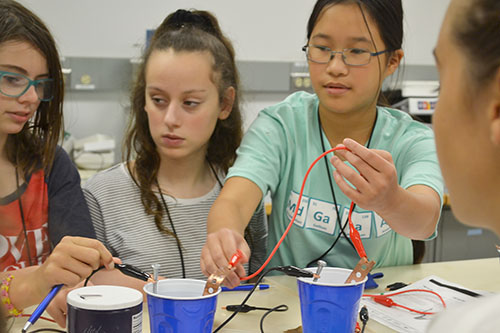
A team of Mid-GLAM campers make a battery using common houshold products, like salt.

A camper enjoys playing with the pretty slime she made.
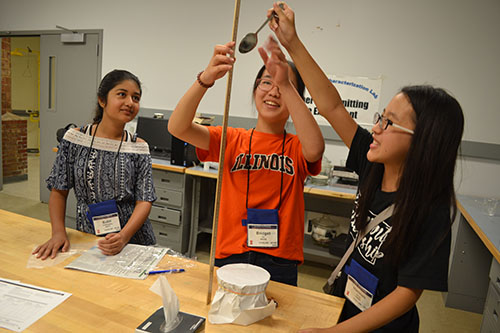
A team of campers test the strength of freezer paper by dropping a spoon on it. They found it to be the strongest of the various materials.
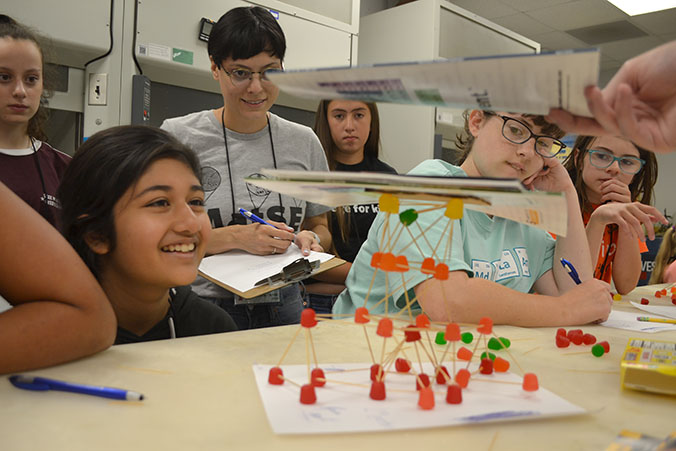 Mid-GLAM campers and lab assistants watch as journals are piled on one team's structure during testing.
Mid-GLAM campers and lab assistants watch as journals are piled on one team's structure during testing. 












.jpg)
















